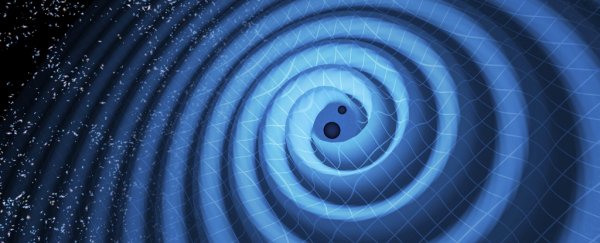The Laser Interferometer Gravitational-wave Observatory (LIGO) has done it again, detecting gravitational waves rippling away from a cosmic collision between a pair of black holes. Only this time, the pair met around 3 billion light-years away.
This is the third time the observatory has successfully measured such an event, but just when you think you've seen it all before, this collision comes with a literal twist – at least one of the black holes seems to be spinning in an unusual direction.
You might remember that LIGO's first big hit was announced back in February 2016, a cautious five months after theoretical ripples in space-time predicted by general relativity were first observed.
A second set of waves was also detected on Christmas Day 2015, making for one colossal stocking filler for scientists.
Researchers have now confirmed that a third black hole merger was detected on 4 January 2017, earning it the memorable name GW170104.
The first collision resulted in a single black hole with a mass of around 62 times that of our Sun, while the second resulted in a comparative lightweight, coming in at just 21 solar masses.
The black hole created by this latest detected merger fills a gap right in-between the first two, being 49 times our Sun's mass.
"We have further confirmation of the existence of stellar-mass black holes that are larger than 20 solar masses – these are objects we didn't know existed before LIGO detected them," says David Shoemaker from MIT, the spokesperson for the LIGO Scientific Collaboration.
But GW170104 appears to be an oddball in at least one other interesting way.
While it might be hard to picture, black holes can actually spin. And we're not just talking about the heated disc of material swirling around it – the actual mass has angular momentum, meaning the black hole itself rotates on its axis.
When two black holes rotate in the same direction as their orbit around one another, astronomers say they are 'aligned'.
"The alignment of the spins can have an effect on the waveform of the gravitational waves that come from the binary black hole system, so sometimes we are able to say whether the spins are aligned or not," Robert Ward from the Australian National University (ANU) who wasn't involved in the finding, explained to ScienceAlert.
And it turns out at least one of GW170104's black holes wasn't aligned.
This provided astronomers with a big clue on how black holes can come together to form a binary system.
Two favoured models suggest they either start as stars already orbiting one another before turning into black holes, which just keep on dancing, or they're two distant black holes that sink in towards one another before falling into orbit.
With this observation of a black hole spinning in the opposite direction to its orbit, astronomers now have evidence of black holes pairing up after their rotations have been established.
As you might imagine, the crashing of black holes rank as some of the Universe's most powerful events, with the first merger seen by LIGO releasing in its final second an estimated 10 times more energy as gravitational waves than the amount of light energy pouring out of every star in the Universe.
Still, at a distance of 1.3 billion light-years, by the time those ripples washed over Earth they'd distorted space on a distance of about a proton.
This latest detected black hole merger was smaller and more than twice the distance away, and was still detectable. And to think, LIGO is just warming up.
"The LIGO detectors are not yet at what we call 'design sensitivity', which basically means operating at their full potential," Ward explained.
Improving design sensitivity could eventually allow us to move onto studying less energetic (but still huge) astronomical phenomena, such as the collisions of neutron stars.
"Once Advanced LIGO reaches its full design sensitivity, it should be able to see binary neutron star mergers out to about 650 million light-years," Susan Scott, also from the ANU, explained to ScienceAlert.
Even the gravitational hum from a neutron star could theoretically be detectable once LIGO is sensitive enough.
"If neutron stars have small deformities in their crust, or minute 'mountains' on them, then as they rotate the changing mass configuration with each rotation due to these asymmetries will produce a continuous stream of gravitational waves," says Scott.
With a star's mass packed into a radius of around 10 kilometres, and hundreds of rotations a second, even a bump just 10 centimetres high could be enough to throw detectable gravitational waves out into the Universe.
Each new event detected also gives physicists one more opportunity to test general relativity.
Rest assured, following this third observation, Einstein's theory is still standing strong, but even a glint of trouble in the theory's accuracy could open the way to new physics that might show how it marries with quantum mechanics.
There's little doubt gravitational wave observatories have already proven their worth, and we'll be using them to hear more from the Universe far into the future.
The findings have been published in Physical Review Letters.
